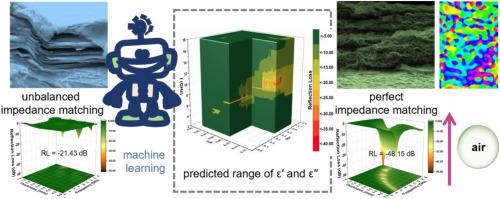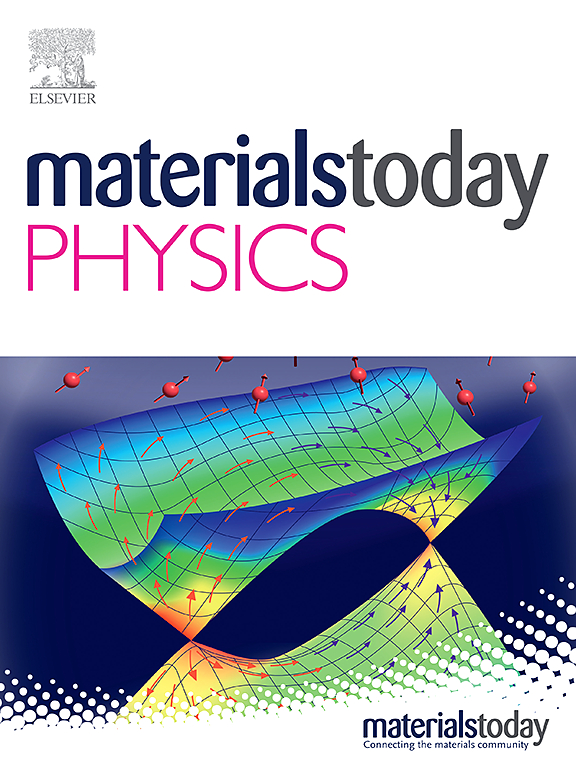增强MXene薄膜微波吸收的机器学习驱动界面工程
IF 9.7
2区 材料科学
Q1 MATERIALS SCIENCE, MULTIDISCIPLINARY
引用次数: 0
摘要
微波吸收材料的微纳结构结构被广泛认为是提高材料性能的有效途径,提供了无限的设计空间。然而,结构-功能黑箱限制了传统的试错法设计和制备吸波材料,其特点是材料微观改性和宏观性能测量之间的周期较长。在这里,我们提出了一种新的基于机器学习的方法来预测具有优异微波吸收性能的材料的电磁参数。通过引入空气,设计了由层状MXene、空心球形MXene、层状MXene、空心球形MXene和层状MXene组成的“五层”薄膜结构,与纯层状MXene薄膜相比,其微波吸收性能大大增强。结果表明,该复合材料的电磁参数得到了精确的调整,阻抗匹配得到了适度的改善,大大提高了薄膜的介电损耗性能。由于微结构特性,薄膜的最小反射损耗(RLmin)为-48.15 dB,最大有效吸收带宽(EABmax)为5.84 GHz。此外,当入射波与平面法线夹角为-60°<;θ& lt;+60°时,将2.5 mm的MXene薄膜覆盖在PEC衬底上,雷达截面(RCS)可降低25.73 dB m2,成功地展示了其实际应用能力。这种机器学习引导的材料合成方法大大缩短了实验时间,为加速高性能微波吸收材料的开发和产业化提供了一条高速公路。本文章由计算机程序翻译,如有差异,请以英文原文为准。


Machine learning-driven interface engineering for enhanced microwave absorption in MXene films
The micro-nanostructure architecture for microwave absorption materials is widely considered an effective approach to enhance the properties of materials, providing unlimited design space. However, the structure-function black box limits the design and preparation of microwave-absorbing materials through traditional trial and error methods, characterized by a time-consuming cycle between microscopic material modification and macroscopic performance measurement. Here, we present a novel machine learning-based approach to predict electromagnetic parameters of materials with excellent microwave absorption properties. Through introducing air, a “five-layer” films structure, composed of lamellar MXene, hollow spherical MXene, lamellar MXene, hollow spherical MXene, and lamellar MXene, is designed, which exhibit greatly enhanced the microwave absorption performance compared with pure layered MXene films. Our results demonstrate that the precise tuning of the electromagnetic parameters and the moderate improvement of the impedance matching achieves within this composite, greatly enhancing the dielectric loss capability of the films. Owing to the microstructural characteristics, the films shows the minimum reflection loss (RLmin) of −48.15 dB and the maximum effective absorption bandwidth (EABmax) of 5.84 GHz. In addition, when the angle between the incident wave and the plane normal is −60° < θ < +60°, the radar cross section (RCS) can be reduced by 25.73 dB m2 when the MXene films with a 2.5 mm layer is covered with the PEC substrate, successfully demonstrating its practical application capability. This machine learning-guided material synthesis approach significantly shortens the experimental time and offers a highway to accelerate the development and industrialization of high-performance microwave absorption materials.
求助全文
通过发布文献求助,成功后即可免费获取论文全文。
去求助
来源期刊

Materials Today Physics
Materials Science-General Materials Science
CiteScore
14.00
自引率
7.80%
发文量
284
审稿时长
15 days
期刊介绍:
Materials Today Physics is a multi-disciplinary journal focused on the physics of materials, encompassing both the physical properties and materials synthesis. Operating at the interface of physics and materials science, this journal covers one of the largest and most dynamic fields within physical science. The forefront research in materials physics is driving advancements in new materials, uncovering new physics, and fostering novel applications at an unprecedented pace.
 求助内容:
求助内容: 应助结果提醒方式:
应助结果提醒方式:


